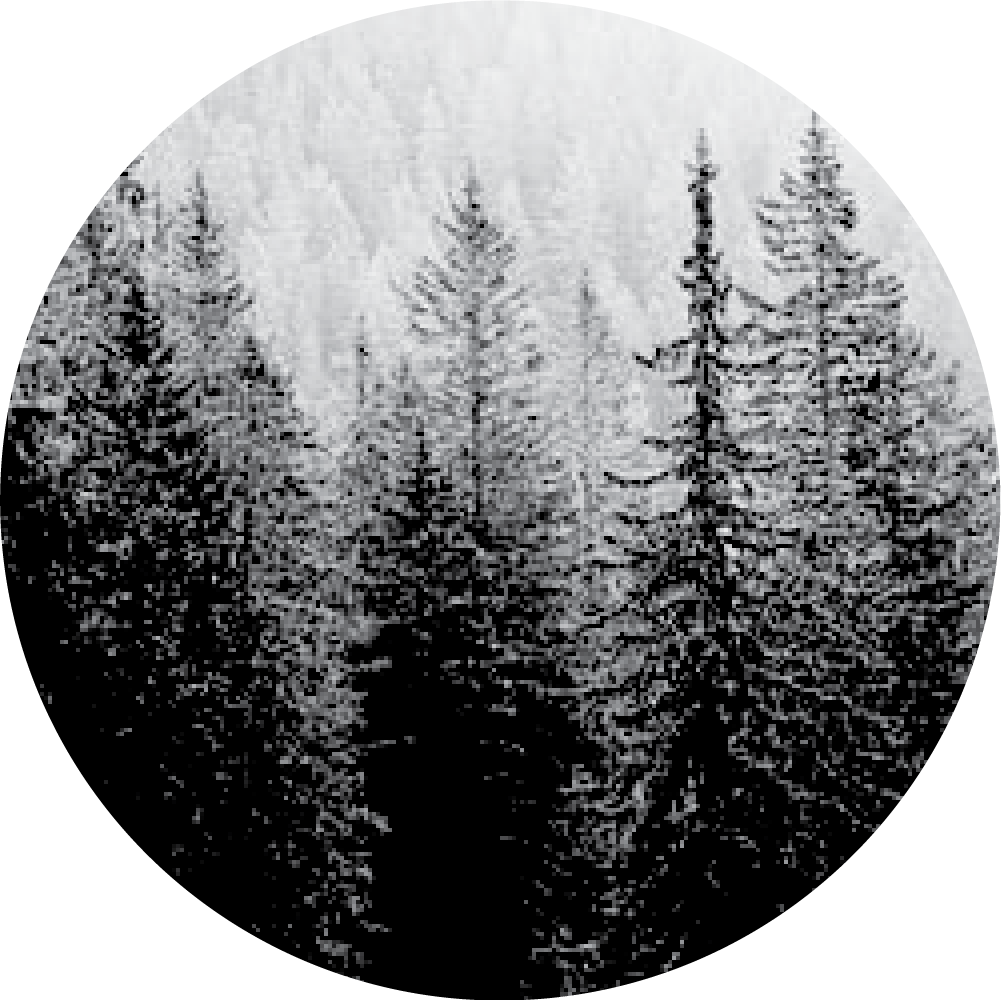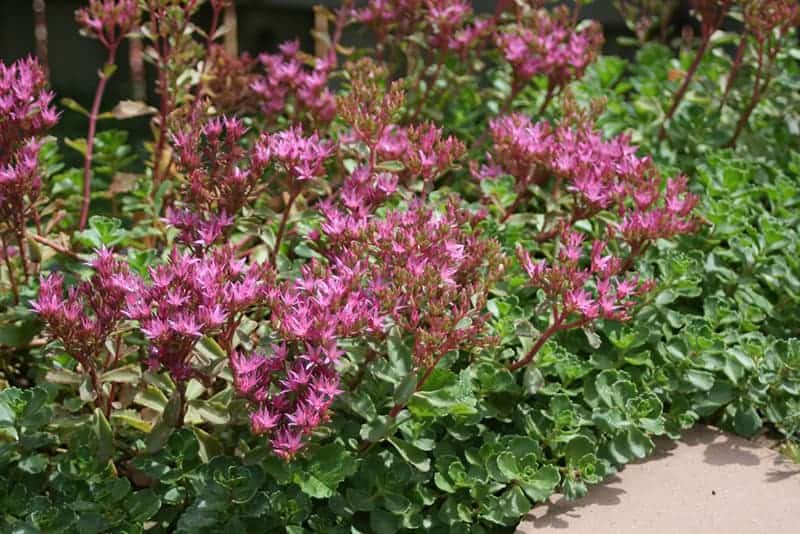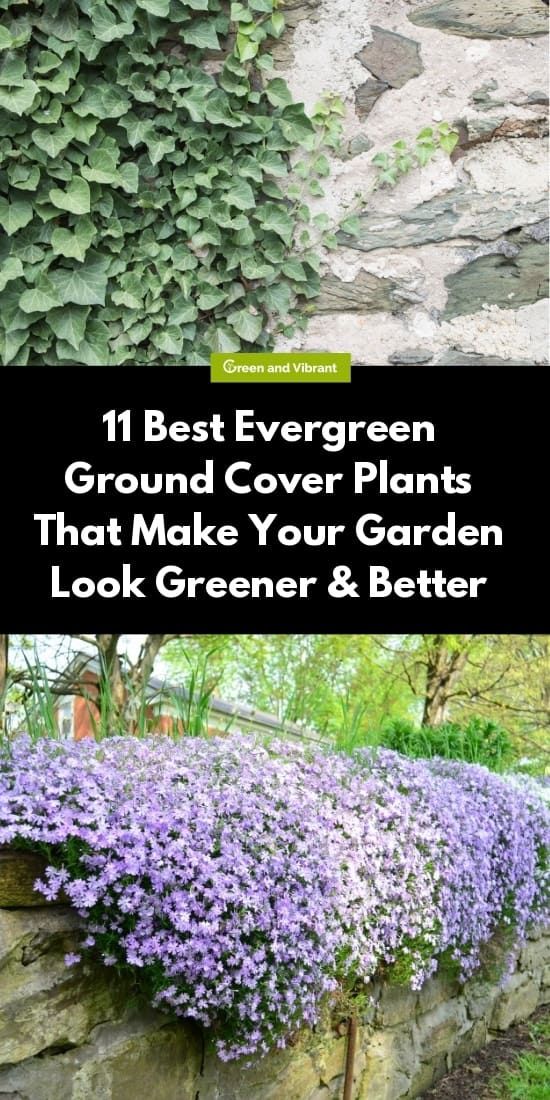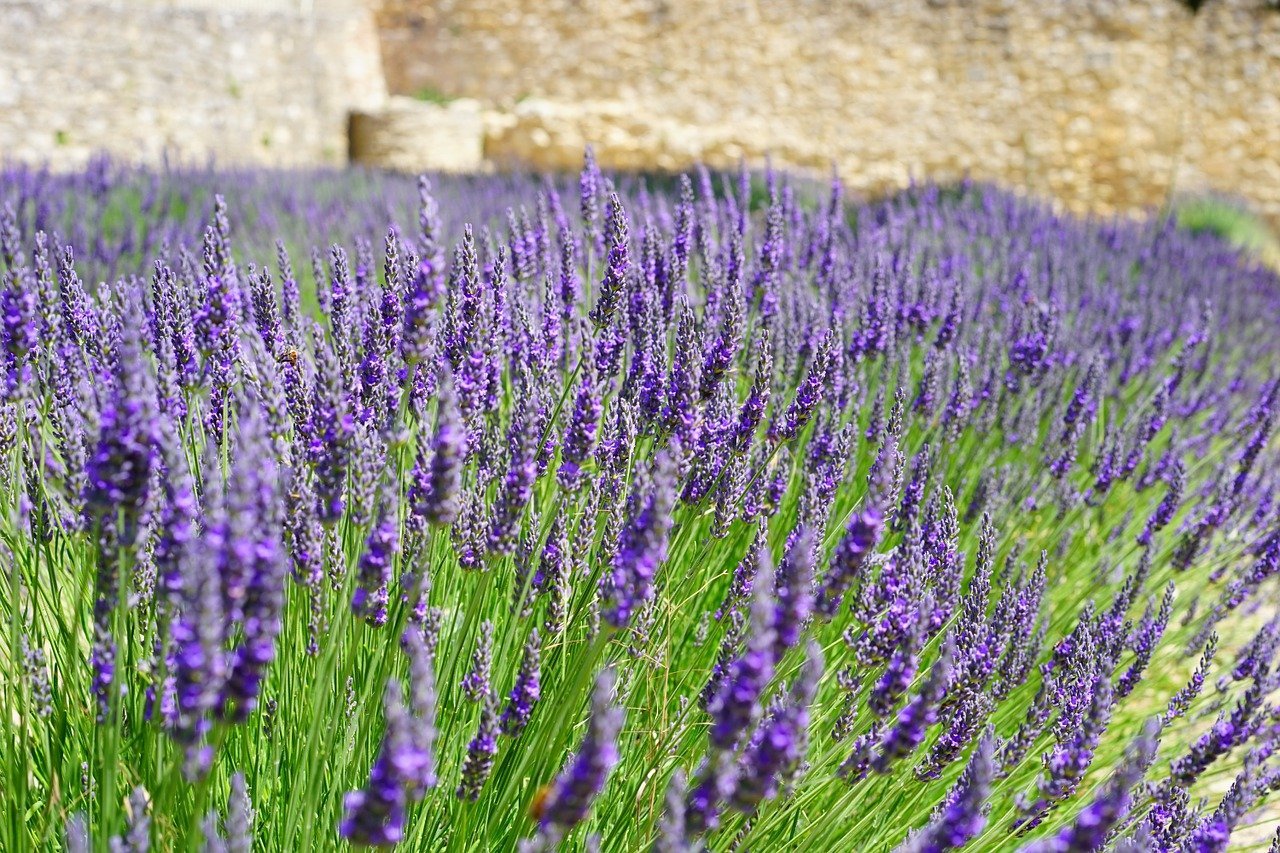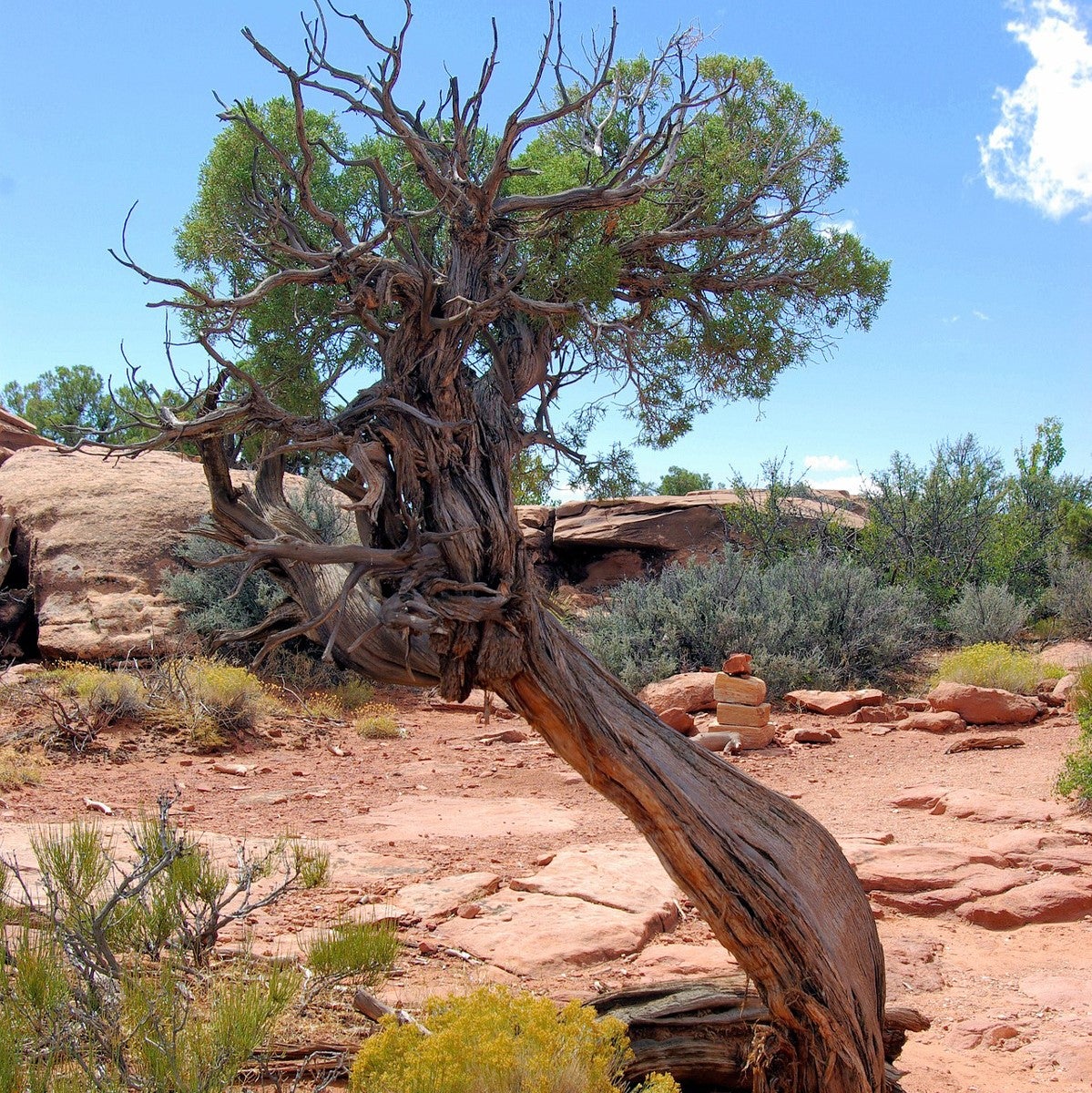- Home >
- Ground Cover Plants >
- Evergreen Ground Cover Plants
Evergreen Ground Cover Plants for Sale - Buying & Growing Guide
Do You Know Your Growing Zone? i Growing zones help determine if a particular plant is likely to grow well in a location. It identifies the average annual minimum winter temperatures across the U.S. provided as a map by the USDA.
13 Results
Evergreen Ground Cover Plants – Buying & Growing Guide
Ground cover plants are low-level plants that spread across the ground to fill in any awkward gaps or vacant areas and create a look of fullness at the base of your larger plants. They operate almost like a carpet, providing an attractive foundation for the rest of your garden to sit on, which gives the feel of a much more finished and well thought out design compared to bare soil. When using ground cover, gardeners often select evergreen types as the foliage keep their color all year-round, providing interest while also typically being low-maintenance.
Benefits of Evergreen Ground Cover Plants
Soil Insulation
Evergreen ground cover plants can operate in a similar way to mulch. As they cover the soil, they are able to offer a layer of insulation, maintaining the soil’s cool temperature in the summer and warm temperature in the winter. This is beneficial to your other plants because it will help protect roots from being damaged by low temperatures in colder seasons. They are also able to trap in moisture in the soil, which means you will need to water plants less frequently and potentially save energy and cut water bills.
Weed Suppressant
Ground cover plants are able to minimize weed production in two ways. First of all, they cover the soil so that it is much harder for weed seeds to germinate. And second, once ground cover plants are mature, they are able to prevent weeds from growing by physically suppressing them. If, like most people, you find weeds to be a nuisance in your garden, then ground cover plants might be an excellent way to tackle them without putting in any hard work. You can say goodbye to the hours spent on your knees digging up weeds, and instead, have some beautiful foliage growing in their place.
Easy Care
Most evergreen ground cover plants are very easy to look after, requiring very little maintenance. They typically grow well in various areas and aren’t too fussy when it comes to the type of soil they prefer. As long as you plant them in an appropriate position so that they have access to enough sunlight or shade, depending on their preference, then you shouldn’t have much trouble getting them to thrive. They also contribute to a low-maintenance yard, as you can grow ground cover plants in place of grass, which will then prevent you from having to mow the lawn.
Year-Round Interest
The main visual benefit of any evergreen plant is that it provides year-round interest in the garden. Often, during winter, gardens can look bleak and dead, but with a good selection of evergreen plants, gardens can look lush throughout every season, as these plants never lose their healthy green foliage.
Prevent Soil Erosion
The web created by ground covering plants helps to keep the soil together and prevent erosion. This can be helpful in gardens with slopes or areas of soil on hillsides or mountainsides, where the soil has a tendency to come loose and slip away. Ground cover plants also prevent erosion during heavy rainfall, which can wash soil away, as the plants help to protect the soil and hold it together.
Fill in Gaps
If you have awkward spaces in your garden or lawn that are difficult to fill, then ground cover plants are an easy solution. They happily grow in all directions to fill any space, making easy work of gaps being filled.
Inexpensive
Evergreen ground cover plants are typically inexpensive if you consider the size of the space they fill for their cost. If you have a large garden then filling it with shrubs or flowering plants can prove quite costly, but the option of leaving the soil bare can look dull and unfinished. In this scenario, ground cover plants offer the perfect solution, covering the soil to create interest and the look of a finished design, without breaking the bank.
Habitat for Beneficial Insects
Ground cover plants create ideal habitats for beneficial insects to live. Having such insects make a home in your garden is good news for your plants because they help keep pest populations down, which could otherwise prove harmful to your plants. Evergreen ground cover plants also create ideal habitats for slugs and snails, which may have a detrimental effect in some areas. In most cases, the benefits of beneficial insects and predators will outweigh the negative of increasing a slug population, but if you are already struggling with a slug problem, then it would be advisable to avoid ground cover plants that will likely worsen your situation.
Improves Soil Quality
Ground cover plants act as natural mulch that can help improve soil quality by increasing the humus level. A better quality soil with more organic matter will result in healthier plants, which are more likely to thrive.
Best Evergreen Cover Plants
1. Creeping Phlox (Phlox subulata)
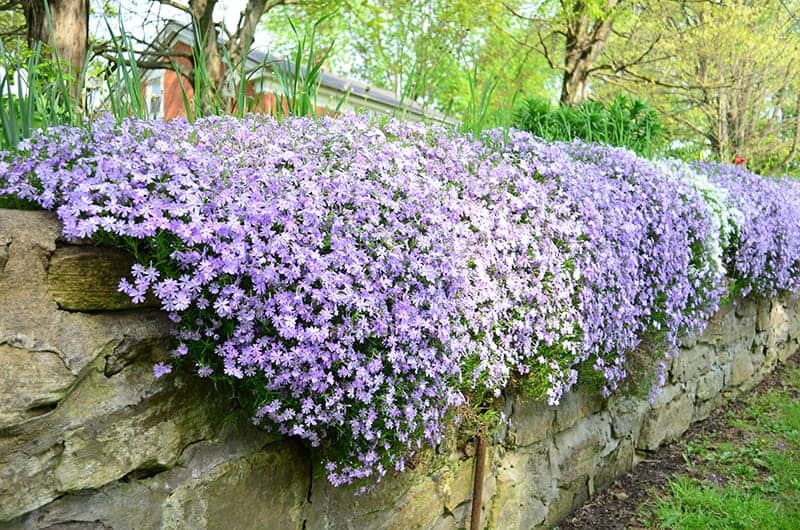
This cascading plant works well in a variety of situations, from ground cover to rockeries, container planters, and hanging baskets. Its evergreen foliage is needle-like, and the starry flowers come in pastel shades of lavender, pink, blue, and white, blooming in spring. The stems, which turn woody over time, have a spreading habit that makes them an ideal candidate for pretty flowering ground cover. However, if you’re looking for a quick fix to cover a vacant space in your garden, then creeping phlox might not be the answer as it only grows at a moderate speed, with a height of around 5 inches and spread of 2 feet.
Creeping phlox is versatile because it can grow in full sun to partial shade, though it would prefer full sun given the option. It can also tolerate a variety of soil conditions but would prefer a well-draining, moist soil. In general, this is an easy-growing plant, though some maintenance is required to keep it flourishing. Mature stems may not re-flower, so pruning stems is necessary to encourage new blooms.
2. Japanese Spurge (Pachysandra terminalis)
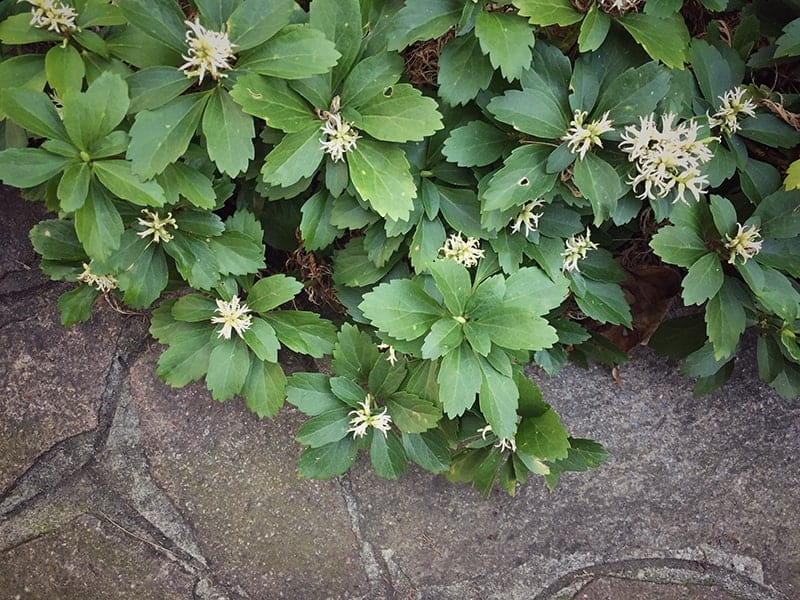
This is a tough ground cover plant that is tolerant of many conditions that other plants would not survive. It likes to be in partial to full shade, which makes it useful for planting in dark corners of gardens or shaded areas under trees. It is also tolerant of drought, though it needs plentiful water when young to help it become established.
Once mature, it can continue to thrive even with very little moisture. It enjoys an acidic soil that is high in organic material, but it will still grow well in poor soil, including high clay content. As an added bonus, this plant is also resistant to most pests. The hardy nature of this plant has its obvious benefits, but being so tough also has its drawbacks. The plant’s ability to withstand less than ideal conditions has led to it also becoming a mildly invasive species in some areas. Keep it under control with annual pruning in spring.
Japanese spurge does produce a small white flower, but these are fairly inconsequential, and in fact, the plant is usually grown just for its leathery green foliage. Over winter, the leaves do tend to yellow, but being an evergreen, the plant does not lose its leaves.
3. Bearberry (Arctostaphylos uva-ursi)
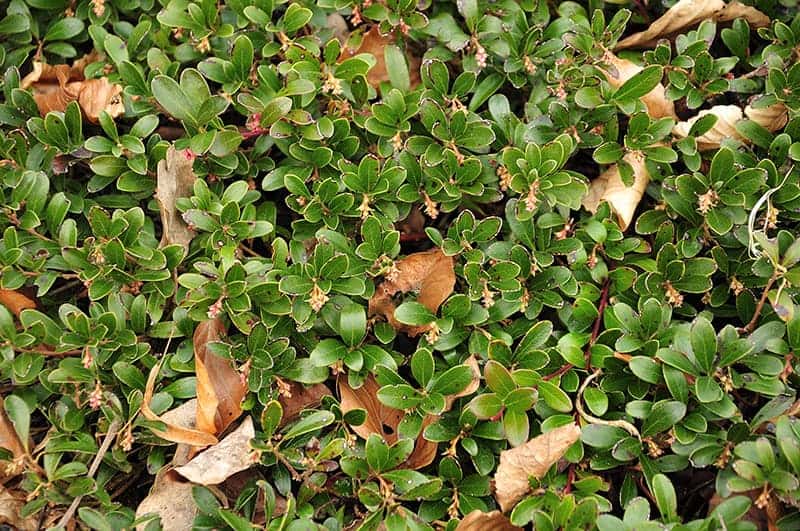
Native to North America, Asia, and Europe, this low-growing shrub is exceptionally winter hardy and makes excellent ground cover in colder climates. It actually fares much better in low temperatures than it does in high temperatures and will struggle to grow well in hot or humid environments. It is known for growing well in poor or infertile soil, though given a choice, it would ideally like to be in a well-draining, moderately moist soil, in full sun.
It has a slow creeping habit, typically growing to between 3 and 6 feet wide by rooting at nodes that come into contact with the ground. This plant is very attractive, with dark green shiny foliage that bronzes over winter before transforming back to green in springtime. Spring also brings with it an abundance of clustered flowers that bloom early in the season, usually in April or May.
The small flowers are just a quarter-inch long and are creamy pink. Once the flowers have gone, the plant produces spherical, red fruits that resemble berries. Though these fruits are edible, they are not cultivated for consumption as they are considered bland, though they are popular among birds and other small creatures. This plant is predominantly used as a medium to large-scale ground cover, though it can also be used successfully in rock gardens, containers, or draping over walls. As with all evergreens, this plant provides year-round interest in the garden, though the production of both the flowers and the berries give the plant a changing seasonal interest.
4. English Ivy (Hedera helix)
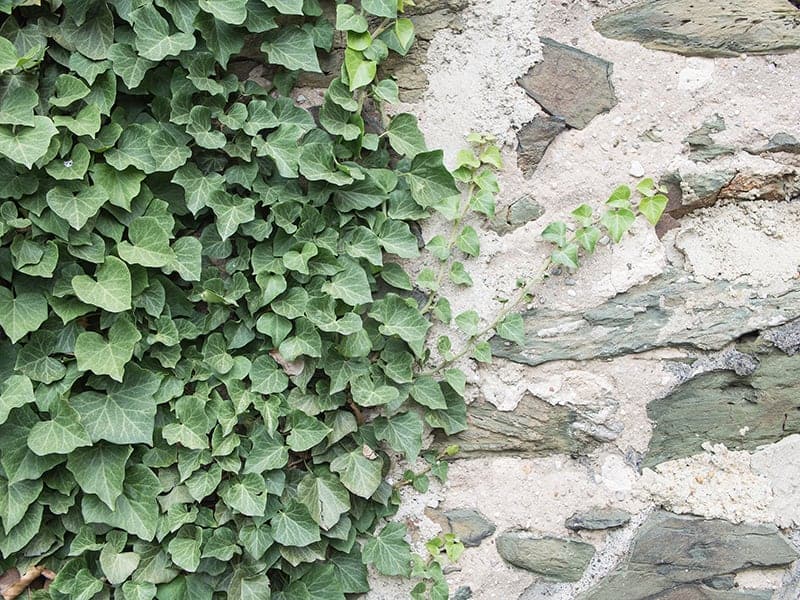
English Ivy is an enormously popular choice for ground cover as it can create a dense blanket of cover in a relatively short amount of time and requires practically no care at all. It covers the ground so heavily that it works very well to prevent weeds from growing and also holds the ground together well to prevent soil erosion.
It’s creeping, climbing, and trailing habit make it ideal for a whole host of scenarios, and it can grow in the shade, so it is able to grow under cover of trees where many other plants cannot grow. It will grow in full sun, but too much harsh direct sun can burn the leaves or cause them to change color. It prefers a well-draining soil high in organic content, though it will grow well in almost any type of soil. Ivy has become a nuisance in some areas as it grows to excess and can get so dominant that it prevents other nearby plants from growing.
Be careful not to plant it too close to other delicate plants that may suffer inhibited growth. To keep your ivy from getting out of control, you can prune it back, ideally in spring. Ivy responds well to pruning and will not be harmed by vigorous cutting back.
5. Creeping Juniper (Juniperus horizontalis)
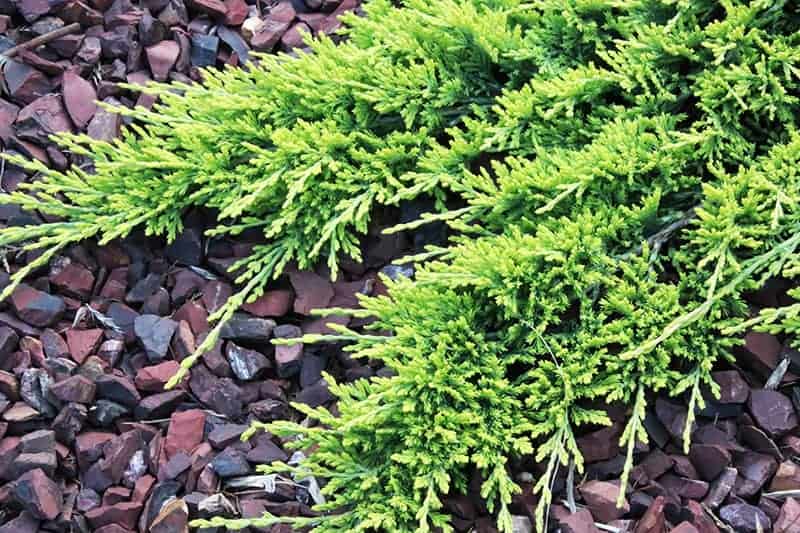
This low-growing creeping shrub is most commonly used as a ground cover plant, and due to its aromatic scent is best utilized in areas where people can enjoy the fragrance, such as along pathways, near seating areas, or around porches. This plant produces both flowers and berries, though neither are considered to be particularly attractive.
Instead, the creeping juniper is grown for its foliage, which takes on a blue tint during warmer months and a purple-red tint in colder months. With a typical height of just 6 inches but a spread of up to 8 feet, this plant is great for covering large areas. Its benefits are that it is particularly good at preventing soil erosion when grown on slopes or hillsides, and it is incredibly easy to grow and actually thrives on neglect.
Though it prefers well-draining soil and a position of full sun, it will grow very well in dry and infertile soil and in hot conditions where most other ornamental plants would struggle. As well as being tolerant of neglect and various growing conditions, this plant also requires no maintenance. It doesn’t need to be pruned as many creeping ground cover plants do, and in fact does not respond well to being cut back, so is better off left to its own devices to spread as it pleases.
6. Candytuft (Iberis sempervirens)
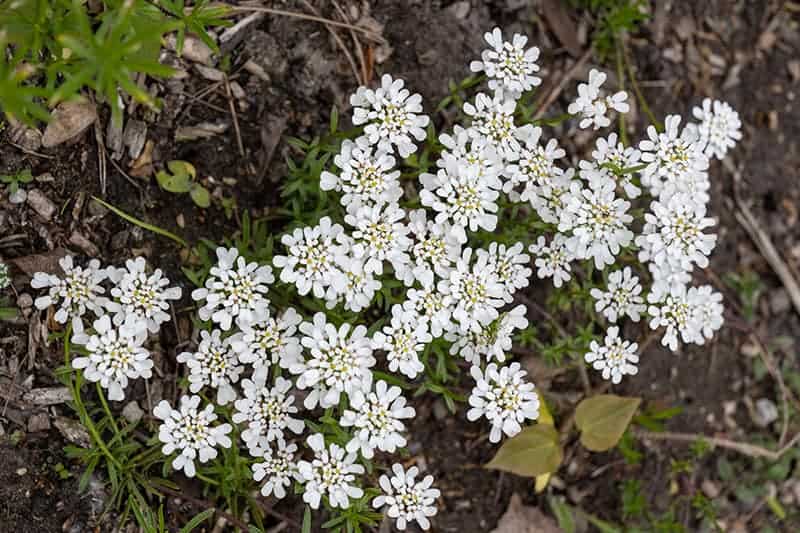
This decorative shrub produces an abundance of showy white flowers in late spring and early summer, with evergreen foliage year round. It is a good ground cover option if you are looking for something with more of a visual interest than standard green carpet ground cover. It grows well in free-draining soil and full sun and ideally should be allowed these conditions if you want it to produce the mass of flowers it is known for. Aside from its preference for full sun, this plant is hassle-free to grow and has very little need for care or maintenance. It is incredibly rewarding for very little work and can grow at an impressive rate to cover ground quickly.
7. Wintercreeper (Euonymus fortunei)
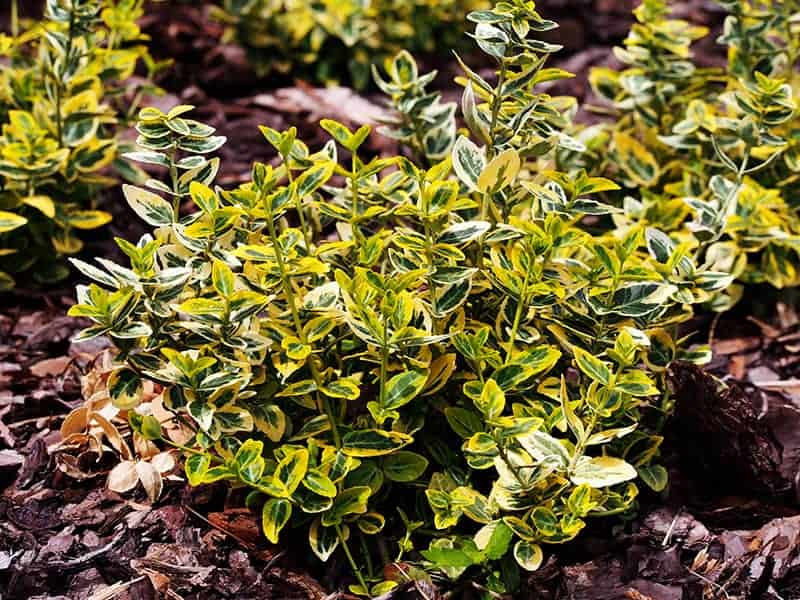
Grown as ground cover, this plant grows to around one foot in height, but its spread knows no bounds. With a similar growth pattern to Ivy, this plant will spread across the ground, climb up walls, fences, trees, or anything else it can grip hold of. As the name suggests, it creeps with ease to rapidly fill a space with its evergreen foliage.
Many varieties are available, with several different colors of foliage to choose from, including variegated green and gold types. This plant likes to grow in partial shade, though it will still grow in almost full shade. It prefers a regular well-draining soil but will grow in practically any soil type, including infertile or dry soil. The plant is drought-tolerant, and in fact, the only condition it will not grow in is wet soil.
This plant is incredibly resilient and will withstand a range of temperatures and conditions. While this has obvious benefits, it has also contributed to this plant becoming an invasive plant in some areas. It can quickly dominate an area of a garden, overflowing into lawns or other unwelcome areas. If you are wary of this particular trait, select one of the variegated types, as these tend to be less aggressive.
8. Creeping Jenny (Lysimachia Nummularia)
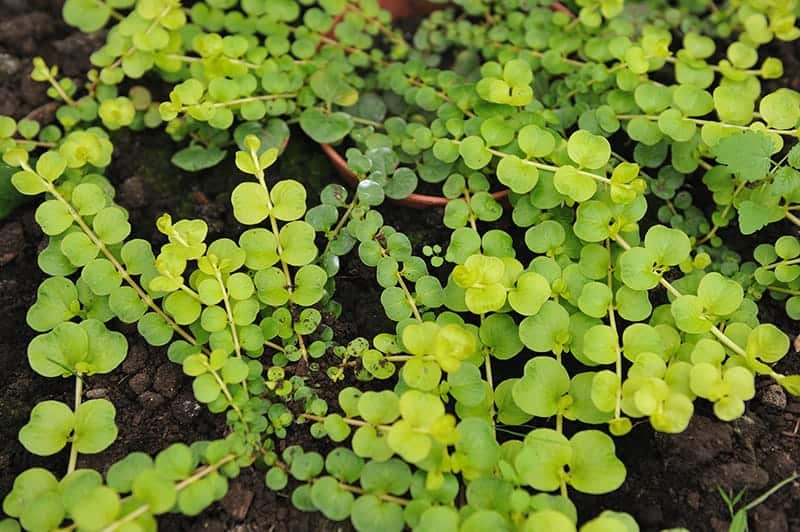
Also commonly known as Moneywort, this pretty ground cover plant produces bright yellow blooms throughout the month of June. The foliage of this plant is also yellow, bringing a shock of color to the garden all year-round. The plant grows best in full sun to partial shade, ideally with full sun in the morning and some shelter from the strong rays of the afternoon. When grown in the sun, the foliage will be a more vibrant yellow, whereas growth in a shaded area will produce a lime green colored foliage. The plant thrives in wet conditions, though soil will need to be well draining to avoid root rot. Dryer soil will help to keep the plant from growing too quickly if this is a concern you have.
This plant works excellent as ground cover in large spaces or areas where it can have the freedom to spread. It grows aggressively to form a low and blanket of cover, suffocating weeds and pulling out roots in its path. When leaf nodes come into contact with the ground, it will take root and spread further, making it a poor choice of ground cover in small flower beds or areas near pathways you would like to keep neat and compact.
9. Trailing Periwinkle (Vinca minor)
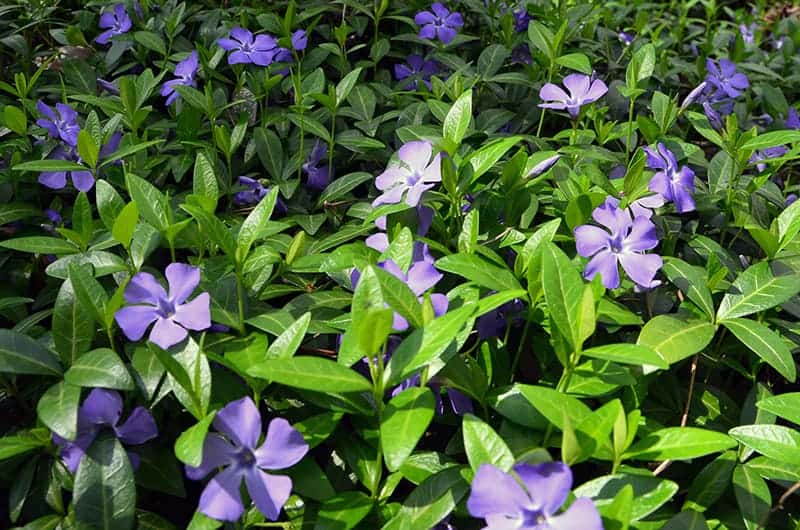
This is a great choice of ground cover plant for any area of the garden because it grows well in any light, including full sun or shade, which is an unusual attribute for a plant. As well as trailing along the ground, this plant trails down the side of wherever it is allowed to grow, making beautiful low-level cascading features in the garden while also offering all the usual benefits of ground cover plants. Grow it along walls where it can drape down and provide visual interest where there wouldn’t ordinarily be any.
One benefit of this plant, if you are looking to cover a large space fairly quickly, is that it grows quickly. Plant it in early spring to allow it the time to grow a strong root system that will be able to withstand low winter temperatures. Within the space of a year, a small plant should have covered several square feet of ground, which is great if you are looking to quickly transform the look of your garden. This, however, could be a drawback if you are growing it in a small space, as it can quickly get out of control. If you want a more manicured look, you will need to keep on top of pruning the plant to prevent it from getting too wild.
This plant is favored by gardeners because of its delicate and pretty blue flowers, which release a fragrant scent, filling the garden with perfume. Plant it under trees for ground cover or in garden beds along pathways where people will walk past and can enjoy the scent.
10. Dragons Blood (Red Sedum)
Credit to patrickstandish
This hardy ground cover plant is a good choice for areas where soil conditions are less than ideal, as it will adapt to poor soil. It is also fairly drought-tolerant and can withstand a wide range of temperatures, making it suitable for planting almost anywhere, particularly in areas where other plants may struggle to survive.
The flowers of this plant, as you may guess from the name, are a deep scarlet red. This plant loves the sun, and the flowers actually respond to it, with the flowers becoming even more vibrant when they have access to long hours in the sun. This plant grows quickly, spreading across the ground to create areas of cover, and at full maturity, it can reach heights of 8 inches.
11. Creeping Thyme (Thymus Serpyllum Coccineus)
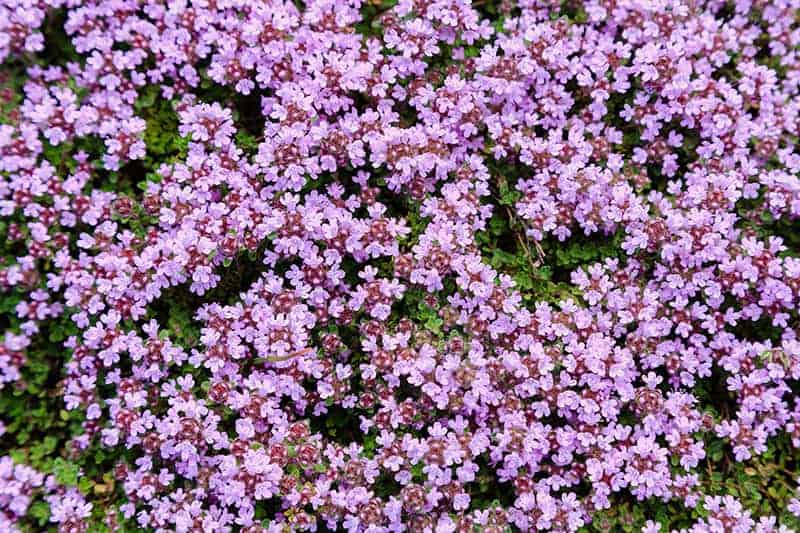
This hardy plant is tolerant of high heat and drought, making it ideal for areas with hotter than average summers and low rainfall. It spreads low along the ground to create very dense blankets of foliage. The fine foliage is evergreen and turns a bronze color in fall and winter. Plentiful delicate purple flowers bloom on 3-inch stems in late June and July, creating a vibrant and colorful blanket on the soil. Once blooms have faded, prune back their stems to promote new growth next year.
This plant is tough enough to withstand foot traffic, making it suitable for planting along walkways and flower bed edges where it may get flattened. If planted in full sun and well-draining soil, this plant will mostly take care of itself. It grows easily and requires very little maintenance, though dead stems can be pruned back each spring to encourage new growth.










